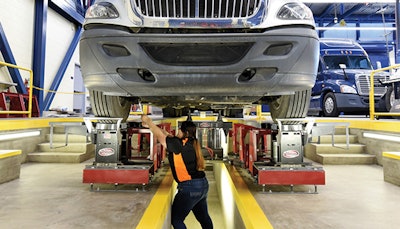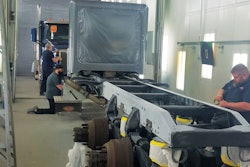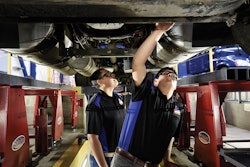
A new way to hire: Why trucking must change its recruitment practices
Trucking has become an industry of shortages. In the fleet community there’s a shortage of drivers. A shortage of truck build slots on the 2019 calendar. A shortage of new freight available.
Shortages haven’t bypassed the parts and service channel, either. Product and employment shortages are as much a part of the aftermarket as brake shoes and filters.
While production shortages commonly are tied to a strong market stressing a supply chain, the source of trucking’s employment shortages are tied to something much more serious.
Trucking’s recruitment pipeline is broken.
In Part II of our 2019 Special Report on trucking’s technician shortage, TPS seeks to explain how trucking’s longstanding technician recruitment tactics have crumbled, and how individual service providers and the industry at large can cooperate to help re-establish a stable recruitment strategy.
One of the most alarming and damaging realities of trucking’s current struggle to find quality technicians is the disconnect existing between vocational education and the industry at large. What was once trucking’s strongest supporter has become an unreliable partner.
Far too many technical schools are teaching curricula for a trucking industry that doesn’t exist — educating students on systems and repairs concerningly antiquated yet also somehow more advanced than what trucking’s entry-level techs require — while the industry itself continues to ignore its failures in transitioning young graduates into its ranks.
The result is a broken recruiting pipeline that’s carrying almost as many young people away from service bays as into them. Trucking’s technician shortage does not exist because no one is interested in the profession; the shortage exists because those who are interested are ultimately choosing not to pursue the industry as a career.
“We always talk about our shortages like there’s nobody out there who wants these jobs, that there is a shortage of people interested in our industry. That’s not true,” says George Arrants, past chairman, ATA’s Technology & Maintenance Council (TMC) SuperTech Competition. “We don’t have a shortage of applicants; we have a shortage of qualified applicants. Those are two very different problems.”
Arrants offers this distinction because he believes it to be the lynchpin to the trucking industry’s current predicament. He says service facilities might not be receiving ideal candidates for the open roles they are trying to fill, but those businesses can’t place blame for their problem on the education system alone. He says the trucking industry has done a terrible job conveying to schools what it expects from the next generation of diesel technicians.
“We don’t let other forms of government spend our money unwisely, so why do we let the schools?” he asks. “We go to these [industry] meetings and talk about the shortage and act like education is someone else’s problem. It’s not.
“If schools aren’t teaching [students] what we need them to teach, we’re responsible for that.”
And what the service channel would like to see taught is more than component identification and basic repair instructions. Vo-tech students and prospective employees also should be briefed on what will be expected of them when they enter the industry, what they’ll be paid and what their long-term future holds.
On that first point, Arrants says it’s time for the trucking industry to wean educators off engine-centric instruction. He says many post-secondary programs are developed and marketed around advanced diesel diagnostics and repair — material that draws interest from prospective students but has little practical value. Entry-level technicians don’t overhaul engines, they perform PMs and CSA inspections. That’s what students need to learn, says Arrants.
Then there’s the financial component. American Diesel Training Centers (ADTC) Co-Founder and President Tim Spurlock says most post-secondary diesel and heavy truck programs promote the earning potential (high five- and six-figure salaries) of technical careers to entice student registrants.
Spurlock says that message isn’t wrong so much as it is misleading because it fails to convey the realistic wages students will be offered upon completion of their degree. Coupled with rising admission rates at these same schools, Spurlock says many young technicians feel overburdened by the financial obligations of their new careers almost immediately.
“I don’t know that there is another business where ‘ghosting’ is more of a thing than this business,” he says. “These guys have financial commitments. If they find somewhere else where they can make another dollar [per hour], they’re gone.”
Too many technical students also are entering school unaware of the financial aid opportunities that exist for them, says Brandon Eckenrode, director of development, Collision Repair Education Foundation (CREF).
“We give out $250,000 to $300,000 in scholarships each year, yet we probably only see a total of 150 to 200 applications,” he says. “We are sitting on more money than we have applicants.”
“[Universal Technical Institute] will make more than $15 million in scholarship and grant money available to students in 2019,” adds Duane Kramer, UTI vice president of education.
Experts add this is an area where industry itself has to do better, both in communicating its financial support to education partners and prospective employees. They say technicians will commit to a business that demonstrates a willingness to financially commit to its associates the same way those associates committed to their new career.
“If your techs have student loans and you hope to keep [those techs], then you have student loans,” says Spurlock.
Finally, the service channel also must improve how it conveys performance expectations and career path potential to new employees, says Homer Hogg, TA/Petro director of technical service.
Once a tech himself, Hogg now oversees more than 3,000 technicians across TA/Petro’s national network of more than 220 locations. Hogg says TA/Petro has invested heavily in a comprehensive technician training and mentorship program to help acclimate its entry-level technicians into its business and showcase the growth potential that exists within the national chain. With 300 to 400 open tech positions at any given time, Hogg says TA/Petro can’t afford to lose a good technician when it is able to recruit one into its operation.
“With unemployment numbers where they are, there are not enough people to go around as it is,” he says.












